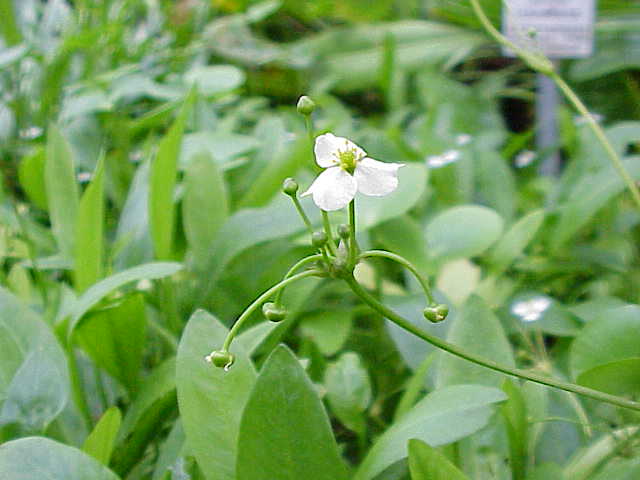- Echinodorus
Taxobox
name = "Echinodorus"

image_width = 240px
image_caption = "Echinodorus isthmicus "
name = "Echinodorus"
regnum =Plant ae
divisio =Magnoliophyta
classis =Liliopsida
ordo =Alismatales
familia =Alismataceae
genus = "Echinodorus"
genus_authority = Richard ex Engelmann in A. Gray, Manual. 460. 1848
subdivision_ranks = Species
subdivision = See text"Echinodorus" (Burhead) is a
genus ofplants in the familyAlismataceae and distributed in theWestern Hemisphere . Its scientific name is derived fromAncient Greek "echius" – rough husk, and "doros" – leathern bottle, alluding to ovaries, which in some species are armed with persistent styles, forming prickly head of fruit.Description
Plants annual or perennial, emersed, floating-leaved, or rarely submersed,
glabrous to stellate-pubescent;rhizomes present or absent;stolons absent;corm s absent;tubers absent.Root s not septate. Leavessessile or petiolate; petioles triangular, rarely terete; blade with translucent markings as dots or lines present or absent, linear to lanceolate to ovate, base attenuate to cordate, margins entire or undulating, apex obtuse to acute.Inflorescences racemes orpanicles , rarely umbels, of 1--18 whorls, erect or decumbent, emersed;bracts coarse, apex obtuse to acute, surfaces smooth or papillose along veins, apex obtuse to acute.Flowers bisexual, subsessile to pedicellate;bracts subtending pedicels, subulate to lanceolate, shorter than to longer than pedicels, apex obtuse to acute; pedicels ascending to recurved; receptacle convex;sepals recurved to spreading,herbaceous to leathery, sculpturing absent;petals white, entire;stamens 9--25; filaments linear,glabrous ; pistils 15--250 or more, spirally arranged on convex receptacle, forming head, distinct;ovules 1; style terminal or lateral.Fruits plump, often longitudinally ribbed, sometimes flattened, rarely abaxially keeled, abaxial wings absent, lateral wings absent, glands often present.Cultivation
"Echinodorus" are by nature marsh and bog plants that can grow submersed. Many species are grown in
aquariums . They prefer good light and grow best in a deep, nutrient-rich substrate. Most will grow in variable water conditions, though the majority need tropical or sub-tropical temperature ranges. Propagation is by division or by new plants developing on submerged flowering stems. The larger species make magnificent specimen plants for the larger aquarium, though they may form aerial leaves in good conditions. If theinflorescence forms submerse small plantlets will form instead of flowers. If grown emerse and kept humid, flowers and seeds will normally readily form. The seeds can be grown in damp sand in warm, damp conditions. Additional CO2 often helps in strong growth.Many species are popular in the
aquarium orpond . The Amazon Sword Plants are one of the most popularaquarium plants for their attractive form and general hardiness.Taxonomy
Approximately 26 species distributed throughout the Western Hemisphere.
The genus "Baldellia" seems to be very closely related.note: in the latest revision by Karel Rataj 62 species, 2 subspecies and 2 varieties are listed. Many cultivars of uncertain taxonomic status are also listed by the
aquarium trade.pecies
*"
Echinodorus angustifolius "
*"Echinodorus argentinensis "
*"Echinodorus aschersonianus "
*"Echinodorus berteroi "
*"Echinodorus bleheri "
*"Echinodorus bracteatus "
*"Echinodorus cordifolius "
*"Echinodorus grisebachii "
*"Echinodorus horizontalis "
*"Echinodorus isthmicus "
*"Echinodorus longiscapus "
*"Echinodorus macrophyllus "
*"Echinodorus nymphaeifolius "
*"Echinodorus opacus "
*"Echinodorus osiris "
*"Echinodorus ovalis "
*"Echinodorus subalatus "
*"Echinodorus tenellus "
*"Echinodorus trialatus "
*"Echinodorus tunicatus "
*"Echinodorus uruguayensis "
*"Echinodorus virgatus "References
* Fassett, N. C. 1955. "Echinodorus" in the American tropics.
* Rhodora 57: 133-156, 174-188, 202-212.
* Haynes, R. R. and L. B. Holm-Nielsen. 1986. Notes on "Echinodorus" (Alismataceae).
* Brittonia 38: 325-332.
* Rataj, K. 1975. Revizion [sic] of the Genus "Echinodorus" Rich. Prague.
* Rataj, K. 2004. A New Revision of the Swordplant genus "Echinodorus"
* Richard, 1848 (Alismataceae).
* Aqua, Special Publication no. 1, March 2004.
* [http://www.unh.edu/herbarium/CostaRica/alisma.html Manual de Plantas de Costa Rica]
* Somogyi, J., "Taxonomic, nomenclatural and chorological notes on several taxa of the genus Echinodorus (Alismataceae)", Biologia 61(4), 2006.External links
* [http://www.echinodorus-online.de/English/Genus/genus.html "Echinodorus"]
* [http://www.webcityof.com/apleaec.htm "Echinodorus" - master list]
* [http://www.wetwebmedia.com/PlantedTksSubWebIndex/echinodorus.htm Swordplants]
* [http://www.mn-aquarium.org/masartaf.htm The Amazon Swordplant - Origins, Identification and Care]
* [http://home10.inet.tele.dk/sveri/menu/plant-fe.html "Echinodorus" species]
* [http://www.aqualandpetsplus.com/Decor%20Amazon%20Sword.htm Caring for Your New Amazon Sword Plant]
* [http://www.aqualandpetsplus.com/Plant,%20More%20Swords.htm More Sword Plants]
* [http://www.aqualandpetsplus.com/Plant,%20Sword%20Plants%20III.htm Sword Plants III]
* [http://www.petsforum.com/MAS/masartaf.htm The Amazon Swordplant : Origins, Identification and Care]
* [http://www.tropica.com/default.asp The hunt for the new Echinodorus]
Wikimedia Foundation. 2010.
